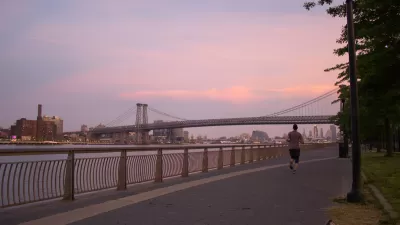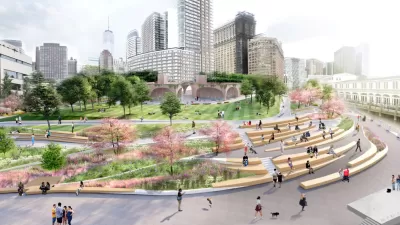Recent disasters have exposed New York's dangerous reliance on consolidated supply chains and just-in-time practices to maintain the city's food supply. Siddhartha Mahanta looks at the food system changes that've left NYC vulnerable to a food crisis.
"In New York City, locating a bite to eat is rarely a difficult task. The city is a food paradise or, depending on your mood, a place of overwhelming glut," writes Mahanta. "But when Superstorm Sandy pummeled New York last fall, it revealed the terrifying potential for sudden food shortages."
The food industry's shift towards "leaner" supply chains have left New York, and other cities, vulnerable to infrastructure and supply disruptions. Yet, worries Mahanta, "[New York City] officials have little concrete data on how reliant their food system is on the private food distribution industry, and whether society is teetering a mere 'nine meals away from revolution' (an ominous old expression that appeared in The Atlantic all the way back in 1945). Worse yet, they have little understanding of the logistical changes that have revolutionized how companies warehouse and distribute the food on which New Yorkers depend."
FULL STORY: New York's Looming Food Disaster

Maui's Vacation Rental Debate Turns Ugly
Verbal attacks, misinformation campaigns and fistfights plague a high-stakes debate to convert thousands of vacation rentals into long-term housing.

Planetizen Federal Action Tracker
A weekly monitor of how Trump’s orders and actions are impacting planners and planning in America.

In Urban Planning, AI Prompting Could be the New Design Thinking
Creativity has long been key to great urban design. What if we see AI as our new creative partner?

King County Supportive Housing Program Offers Hope for Unhoused Residents
The county is taking a ‘Housing First’ approach that prioritizes getting people into housing, then offering wraparound supportive services.

Researchers Use AI to Get Clearer Picture of US Housing
Analysts are using artificial intelligence to supercharge their research by allowing them to comb through data faster. Though these AI tools can be error prone, they save time and housing researchers are optimistic about the future.

Making Shared Micromobility More Inclusive
Cities and shared mobility system operators can do more to include people with disabilities in planning and operations, per a new report.
Urban Design for Planners 1: Software Tools
This six-course series explores essential urban design concepts using open source software and equips planners with the tools they need to participate fully in the urban design process.
Planning for Universal Design
Learn the tools for implementing Universal Design in planning regulations.
planning NEXT
Appalachian Highlands Housing Partners
Mpact (founded as Rail~Volution)
City of Camden Redevelopment Agency
City of Astoria
City of Portland
City of Laramie




























